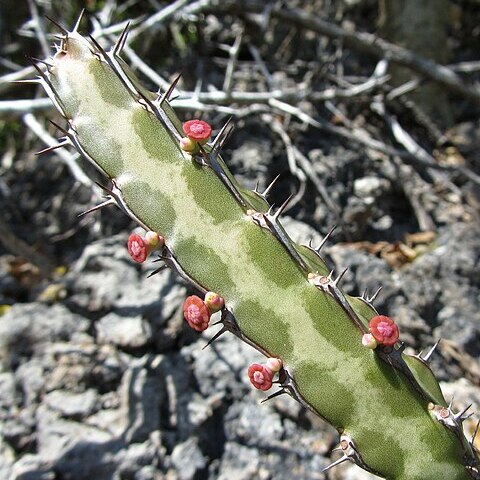Trunk woody, to 12.5(25) cm in diameter; main branches spreading, eventually horizontal, 5-angled, eventually terete; secondary branches in distant whorls, 3–4-angled, c. 2.5 cm in diameter; angles prominent, sinuate with tubercles 1–3 cm apart along the margins.
Spine shields to 8 × 2.5 mm, obtriangular, usually including the flowering eye, often decurrent and joined in a cartilaginous ridge on older branches; spines to 5 mm long, often becoming obsolete; prickles minute or absent.
Cyathia to 4.5 × 9 mm, with broadly campanulate involucres, yellowish to reddish-purple; glands 4.5 mm wide, transversely elliptic, not quite touching, shiny reddish, turning dark purple.
Female flower: perianth 3-lobed, lobes c. 1.25 mm long, irregularly dentate; styles 2 mm long, free almost to the base, spreading, with scarcely bifid capitate apices.
Cymes solitary, central cyathium often bisexual, forking several times; peduncle 3–6 mm long; cyme branches 5–9 mm long; bracts 4 × 5 mm, ovate, caducous.
Capsule deeply lobed, truncate, to 9 × 25 mm, exserted on an erect pedicel to 8 mm long.
Male flowers numerous: bracteoles filiform; stamens c. 5 mm long, anthers almost black.
Leaves to 13 mm in diameter, ± circular, margins strongly revolute, caducous.
Much branched succulent, spiny tree to 4(10) m high.
Seed subglobose, c. 4.5 mm long, minutely rugulose.


